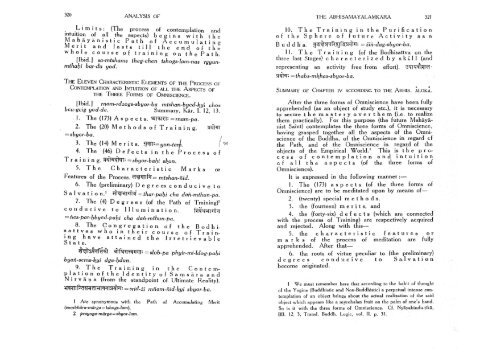ABHISAMAYALAMKARA
ABHISAMAYALAMKARA
ABHISAMAYALAMKARA
You also want an ePaper? Increase the reach of your titles
YUMPU automatically turns print PDFs into web optimized ePapers that Google loves.
320 ANALYSIS OF<br />
L i m i t s : (The process of contemplation and<br />
l/r l t al1 the a<br />
L° _<br />
s P e c t s ) b e g i n s w i t h t h e<br />
M a h a y a n i s t i c P a t h of A c c u m u l a t i n g<br />
M e r i t a n d l a s t s t i l l t h e e n d of t h e<br />
w h o l e c o u r s e pf t r a i n i n g o n t h e P a t h .<br />
[Ibid.] sa-mtshams theg-chen tshogs4am-nas tgyunmthani<br />
bar-du yod.<br />
THE ELEVEN CHARACTERISTIC ELEMENTS OF THE PROCESS OF<br />
CONTEMPLATION AND INTUITION OF ALL THE ASPECTS OF<br />
THE THREE FORMS OF OMNISCIENCE.<br />
[Ibid.] rnam-rdzogs-sbyor-ba mtshan~byed~kyi chos<br />
bcu-gcig yod-de. Summary, Kar. I. 12, 13.<br />
1. The (173) Aspects. 3TOTT5 = mam-pa.<br />
2. The (20) Methods of Training. S#nrr<br />
= sbycr~ba.<br />
3. The (14) Merits. mn^yon-tarf.<br />
4. The (46) Defects in the Process of<br />
Training. STCto^far: = sbyor~bahi<br />
skon,<br />
5. The Characteristic Marks or<br />
Features of the Process. lWTf*T =<br />
mtshan-nid.<br />
6. The (preliminary) Degrees conducive to<br />
Salvation. 1 #f*TFfter = thar-pahi cha dah-mthun~pa.<br />
7. The (4) Degrees (of the Path of Training) 2<br />
conducive to Illumination. "pRWn'for<br />
^nes-par-hbyed-pahi cha dan-mthun-pa.<br />
8. The Congregation of the Bodhis<br />
a t t v a s who in their course of Training<br />
have attained the Irretrievable<br />
State.<br />
byan-sems-kyi<br />
dge-hdun.<br />
: = slob-pa phyir~mi4dog~pahi<br />
9. The Trailing in the Conterap<br />
1 a t i o n o f the Identity of S a m s a r a and<br />
Nirvana (from the standpoint of Ultimate Reality).<br />
q^foRPRn^^^ mnam~nid-kyi sbyor~ba.<br />
1 Are synonymous with the Path of Accumulating Merit<br />
(sambhara~margaz=tshog8-lam).<br />
2 prayoga-marga = s b l<br />
;<br />
THE <strong>ABHISAMAYALAMKARA</strong> 32!<br />
10. The Training in the Purification<br />
of the Sphere of future Activity as a<br />
Buddha : f^^ftgfe^T- =zih-dag-sbyor-ba.<br />
11. The Training (of the Bodhisattva on the<br />
three last Stages) characterized by sk£ll (and<br />
representing an activity free from, effort).<br />
r: = thabs-mkhas-sbyor-ba.<br />
SUMMARY OF CHAPTER IV ACCORDING TO THE ABHIS. ALOKA.<br />
After the three forms of Omniscience have been fully<br />
apprehended (as an object of study etc.), it is necessary<br />
to secure the mastery over t h e m (i.e. to realize<br />
them practically). For this purpose (the future Mahayanist<br />
Saint) contemplates the three forms of Omniscience,<br />
having grasped together all the aspects of the Omniscience<br />
of the Buddha, of the Omniscience in regard of<br />
the Path, and of the Omniscience 1 in regard of the<br />
objects of the Empirical World. 1 This is the process<br />
of contemplation, and intuition<br />
of all the aspects (of the three forms of<br />
Omniscience).<br />
It is expressed in the following manner :—<br />
1. The (173) aspects (of the three forms of<br />
Omniscience) are to be meditated upon by means of—<br />
2. (twenty) special methods.<br />
3. the (fourteen) merits, and<br />
4. the (forty-six) defects (which are connected<br />
with the process of Training) are respectively acquired<br />
and rejected. Along with tjiis—<br />
5. the characteristic features or<br />
marks of the process of meditation are fully<br />
apprehended. After that—<br />
6. the roots of virtue peculiar to (the preliminary)<br />
degrees conducive to* Salvation<br />
become originated.<br />
1 We must remember here that according to the hab ; ,t of thought<br />
of the Yogins (Buddhistic and Non-Buddhistic) a perpetual intense contemplation<br />
of an object brings about the actual realization of the said<br />
object which appears like a myrobalan fruit on the palm of one's hand.<br />
So is it with the three forms of Omniscience. Cf. Nyayabindu-tika,<br />
BB. 12, 3, Transl. Buddh. Logic, vol. II. p. 31.












![Long Discourses of the Buddha [Digha Nikaya]](https://img.yumpu.com/32792419/1/164x260/long-discourses-of-the-buddha-digha-nikaya.jpg?quality=85)


